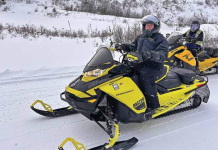Waterfront property owners are being advised that traditionally low water levels have arrived early this year – and they should be ready in case they have to take action, such as moving docks and water lines and taking boats out of the water early.
“There’s going to be people whose boats are stuck in the mud this coming weekend,” said Carol Moffatt, who is a member of the Coalition for Equitable Water Flow (CEWF) executive committee.
Moffatt added that depending on people’s lakes, “the (low) water levels are two to four weeks ahead of normal.”
CEWF is recommending people be attentive to the Trent Severn Waterway drawdown and fully understand it is 14 to 28 days ahead of usual.
Asked if any lakes in particular were experiencing extreme low water levels, Moffatt said, “each lake is affected differently, but the percentage of fill across the board is generally the mid-to- high 50 per cents. If this was October, it wouldn’t really matter, but it’s August.”
She said what CEWF is also trying to do is get people “to be a little more self-starting” by looking at CEWF’s website and the Trent Severn’s live water map and graphs.
“All of the lakes where there are dams; they all have a graph. You can look at the graph and go ‘yikes, my water seems to be very close to the all-time low.’ So, if CEWF says ‘hey, heads up,’ that people immediately go and look at their graph and go ‘okay, I need to take care of whatever I need to take care of’.”
Moffatt said the last time the region experienced extreme low water levels was 2012. She said it was a drought summer, “not dissimilar to this one” and people experienced problems.
She said someone on the Boshkung Lake page had posted they took their boat out three weeks ago because it is a deep hull boat and they cannot get under the bridge to get to the boat launch if the water is too low.
“People also need to be aware of how these levels affect their local boat ramp should they have one. Some boat ramps are a bit more of a deep-water boat ramp. Some, like Little Boshkung, go into shallow water and a sand bar.
“Know your lake, know your levels, know your boat ramp, know your own personal foot valve and boating situation and plan accordingly.”
Moffatt: TSW has done a really good job
Moffatt added some people think the Trent Severn draws water “so people on the canal can ride around on their boats.” She said it may be true, but is not accurate. She said the TSW has to maintain minimum flows to service municipal water systems, such as in Peterborough. So, it is the same flow for drinking water and navigation; with the priority being the water system.
She added, “the daily working considerations for the system have been supported by TSW. They’re not just saying ‘we need some water, we’re going to take it from lake A to Z…they have done a really good job, as best they can, in maintaining the minimum flows across the watershed.”
She added they have done so in extreme weather. “It’s not just that the rain is not filling the watershed, it’s also that the heat and the wind is evaporating what water we have …and then you add the water they have to take and you end up in the situation we’re in.”
Moffatt reiterated, “if we don’t get a lot of rain and you don’t make a plan, then don’t be surprised if, in two weeks, your boat’s in the mud.”
Go to CEWF.ca for more information.




